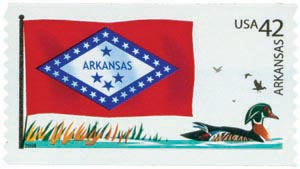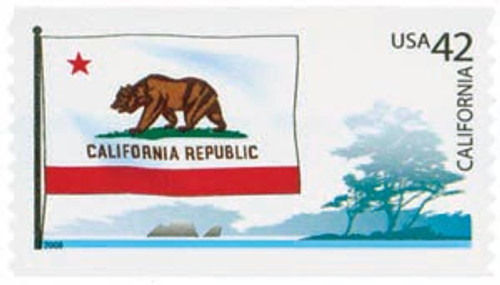
# 4278 - 2008 42c Flags of Our Nation: Arkansas
Flags of Our Nation
City: Washington, DE
Arkansas Becomes 25th State
Indians had lived in Arkansas as early as 10,000 B.C. When the first European explorers arrived, they found three main tribes in the area: the Caddo, Osage, and Quapaw.
Hernando de Soto of Spain was the first European to reach the Mississippi River. He arrived in 1541, near what is now Memphis, Tennessee. He then crossed Arkansas and reached the Ozark Mountains. In 1673, Father Jacques Marquette and Louis Jolliet traveled down the Mississippi to the mouth of the Arkansas River. René-Robert Cavelier, Sieur de La Salle, claimed the entire Mississippi River valley, which includes Arkansas, for France in 1682. He called the claim Louisiana, in honor of King Louis XIV.

In 1686, Henri de Tonti built a camp at the mouth of the Arkansas River. Arkansas’ first permanent white settlement, Arkansas Post, was founded near there. To develop that vast Louisiana territory, France gave control of the area to the Western Company. The Western Company brought several hundred colonists to Arkansas. However, the effort was largely unsuccessful, and many of the colonists left.
Spain gained ownership of France’s lands west of the Mississippi in 1763. France took the land back in 1800. Then, in 1803, the area was sold to the United States in the Louisiana Purchase.

In 1812, Arkansas and the northern part of the Louisiana Territory were organized as the Missouri Territory. Congress created the Arkansas Territory in 1819. It included today’s Arkansas and part of Oklahoma. The Arkansas River Valley served as a route to the Far West, and many travelers passed through the state. Van Buren and Fort Smith became important trade centers.
The issue of statehood was first raised in 1831. Republicans in the state favored statehood, while Democrats worried that the taxes to run a state government would be too high for the potential state’s small population. When they learned Michigan was applying for statehood as a free state, Arkansas politicians saw it as their chance to apply as a slave state. Both applications were rejected, but the people from each territory began drawing up state constitutions. The Arkansas politicians sent their new constitution to Washington, where it was debated over for 25 hours on the slavery issue. Eventually though, President Andrew Jackson signed the bill creating the state of Arkansas on June 15, 1836.
Arkansas had joined the Union just as the national debate over the future of slavery in America was becoming more and more intense. After Abraham Lincoln’s election in 1860, several slave states began to secede. As a slave state, Arkansas was torn as to what course of action it should take. In March of 1861, an Arkansas convention voted to stay within the Union. However, when President Lincoln called for Union states to provide troops for the war, Arkansas refused. Then, in May of 1861, another state convention voted to secede.

In March of 1862, Union forces won an important battle at Pea Ridge, Arkansas. Northern troops pushed the Confederates into the southern portion of the state. On September 10, 1863, the Union army captured Little Rock, so the Confederates established a new capital at Washington, Arkansas. In 1864, a group of pro-Union Arkansans formed a government at Little Rock. This government’s constitution abolished slavery. Both governments existed until the war ended in 1865.
Federal troops occupied Arkansas from 1867 to 1874, and the entire state was under military authority. In 1868, the state passed a law giving blacks the right to vote. That year, Arkansas was readmitted into the Union. Arkansas was among the most fervent states in application of racial segregation laws. To give an idea of the scope of this segregation, many courts in Arkansas supplied different Bibles for swearing in witnesses of different races.
During the late 1800s, Arkansas entered a period of continuing economic expansion. This growth was spurred by the construction of railroads, which allowed industry and agriculture to prosper. Deposits of the mineral bauxite were discovered near Little Rock in 1887, and many mines were opened. By 1900, many large sawmills and other timber-related industries had begun to flourish in Arkansas. Oil was discovered near El Dorado in 1921, and the state’s first hydroelectric dam was built in 1924.

In 1932, Arkansas elected the first woman to serve in the U.S. Senate. Hattie Caraway was awarded that office after winning a special election held shortly after her husband, U.S. Senator Thaddeus Caraway, died.
Farming and mining expanded greatly in Arkansas during World War II. However, after the war, the state’s economy began to move away from agriculture toward industrialization. Many farm workers lost their jobs due to greater reliance on machinery. And although new manufacturing jobs helped to employ many of these workers, there simply weren’t enough for all those displaced from the state’s farms. As a result, many workers left the state, despite the fact that the number of manufacturing plants more than doubled during the 1940s and 1950s. In the 1960s, Arkansas manufacturing became more profitable than its farms for the first time.

In 1970, the Arkansas River Development Program was completed. This project made the Arkansas River navigable from the Mississippi River into Oklahoma. Industrial expansion has brought the state many of the same problems faced by other states: air and water pollution, energy shortages, and housing shortages. The state has strived to improve its public education, including increased vocational education to provide the state’s industry with skilled workers. Increased tourism has also provided Arkansas with additional income and jobs.
Flags of Our Nation
City: Washington, DE
Arkansas Becomes 25th State
Indians had lived in Arkansas as early as 10,000 B.C. When the first European explorers arrived, they found three main tribes in the area: the Caddo, Osage, and Quapaw.
Hernando de Soto of Spain was the first European to reach the Mississippi River. He arrived in 1541, near what is now Memphis, Tennessee. He then crossed Arkansas and reached the Ozark Mountains. In 1673, Father Jacques Marquette and Louis Jolliet traveled down the Mississippi to the mouth of the Arkansas River. René-Robert Cavelier, Sieur de La Salle, claimed the entire Mississippi River valley, which includes Arkansas, for France in 1682. He called the claim Louisiana, in honor of King Louis XIV.

In 1686, Henri de Tonti built a camp at the mouth of the Arkansas River. Arkansas’ first permanent white settlement, Arkansas Post, was founded near there. To develop that vast Louisiana territory, France gave control of the area to the Western Company. The Western Company brought several hundred colonists to Arkansas. However, the effort was largely unsuccessful, and many of the colonists left.
Spain gained ownership of France’s lands west of the Mississippi in 1763. France took the land back in 1800. Then, in 1803, the area was sold to the United States in the Louisiana Purchase.

In 1812, Arkansas and the northern part of the Louisiana Territory were organized as the Missouri Territory. Congress created the Arkansas Territory in 1819. It included today’s Arkansas and part of Oklahoma. The Arkansas River Valley served as a route to the Far West, and many travelers passed through the state. Van Buren and Fort Smith became important trade centers.
The issue of statehood was first raised in 1831. Republicans in the state favored statehood, while Democrats worried that the taxes to run a state government would be too high for the potential state’s small population. When they learned Michigan was applying for statehood as a free state, Arkansas politicians saw it as their chance to apply as a slave state. Both applications were rejected, but the people from each territory began drawing up state constitutions. The Arkansas politicians sent their new constitution to Washington, where it was debated over for 25 hours on the slavery issue. Eventually though, President Andrew Jackson signed the bill creating the state of Arkansas on June 15, 1836.
Arkansas had joined the Union just as the national debate over the future of slavery in America was becoming more and more intense. After Abraham Lincoln’s election in 1860, several slave states began to secede. As a slave state, Arkansas was torn as to what course of action it should take. In March of 1861, an Arkansas convention voted to stay within the Union. However, when President Lincoln called for Union states to provide troops for the war, Arkansas refused. Then, in May of 1861, another state convention voted to secede.

In March of 1862, Union forces won an important battle at Pea Ridge, Arkansas. Northern troops pushed the Confederates into the southern portion of the state. On September 10, 1863, the Union army captured Little Rock, so the Confederates established a new capital at Washington, Arkansas. In 1864, a group of pro-Union Arkansans formed a government at Little Rock. This government’s constitution abolished slavery. Both governments existed until the war ended in 1865.
Federal troops occupied Arkansas from 1867 to 1874, and the entire state was under military authority. In 1868, the state passed a law giving blacks the right to vote. That year, Arkansas was readmitted into the Union. Arkansas was among the most fervent states in application of racial segregation laws. To give an idea of the scope of this segregation, many courts in Arkansas supplied different Bibles for swearing in witnesses of different races.
During the late 1800s, Arkansas entered a period of continuing economic expansion. This growth was spurred by the construction of railroads, which allowed industry and agriculture to prosper. Deposits of the mineral bauxite were discovered near Little Rock in 1887, and many mines were opened. By 1900, many large sawmills and other timber-related industries had begun to flourish in Arkansas. Oil was discovered near El Dorado in 1921, and the state’s first hydroelectric dam was built in 1924.

In 1932, Arkansas elected the first woman to serve in the U.S. Senate. Hattie Caraway was awarded that office after winning a special election held shortly after her husband, U.S. Senator Thaddeus Caraway, died.
Farming and mining expanded greatly in Arkansas during World War II. However, after the war, the state’s economy began to move away from agriculture toward industrialization. Many farm workers lost their jobs due to greater reliance on machinery. And although new manufacturing jobs helped to employ many of these workers, there simply weren’t enough for all those displaced from the state’s farms. As a result, many workers left the state, despite the fact that the number of manufacturing plants more than doubled during the 1940s and 1950s. In the 1960s, Arkansas manufacturing became more profitable than its farms for the first time.

In 1970, the Arkansas River Development Program was completed. This project made the Arkansas River navigable from the Mississippi River into Oklahoma. Industrial expansion has brought the state many of the same problems faced by other states: air and water pollution, energy shortages, and housing shortages. The state has strived to improve its public education, including increased vocational education to provide the state’s industry with skilled workers. Increased tourism has also provided Arkansas with additional income and jobs.

















